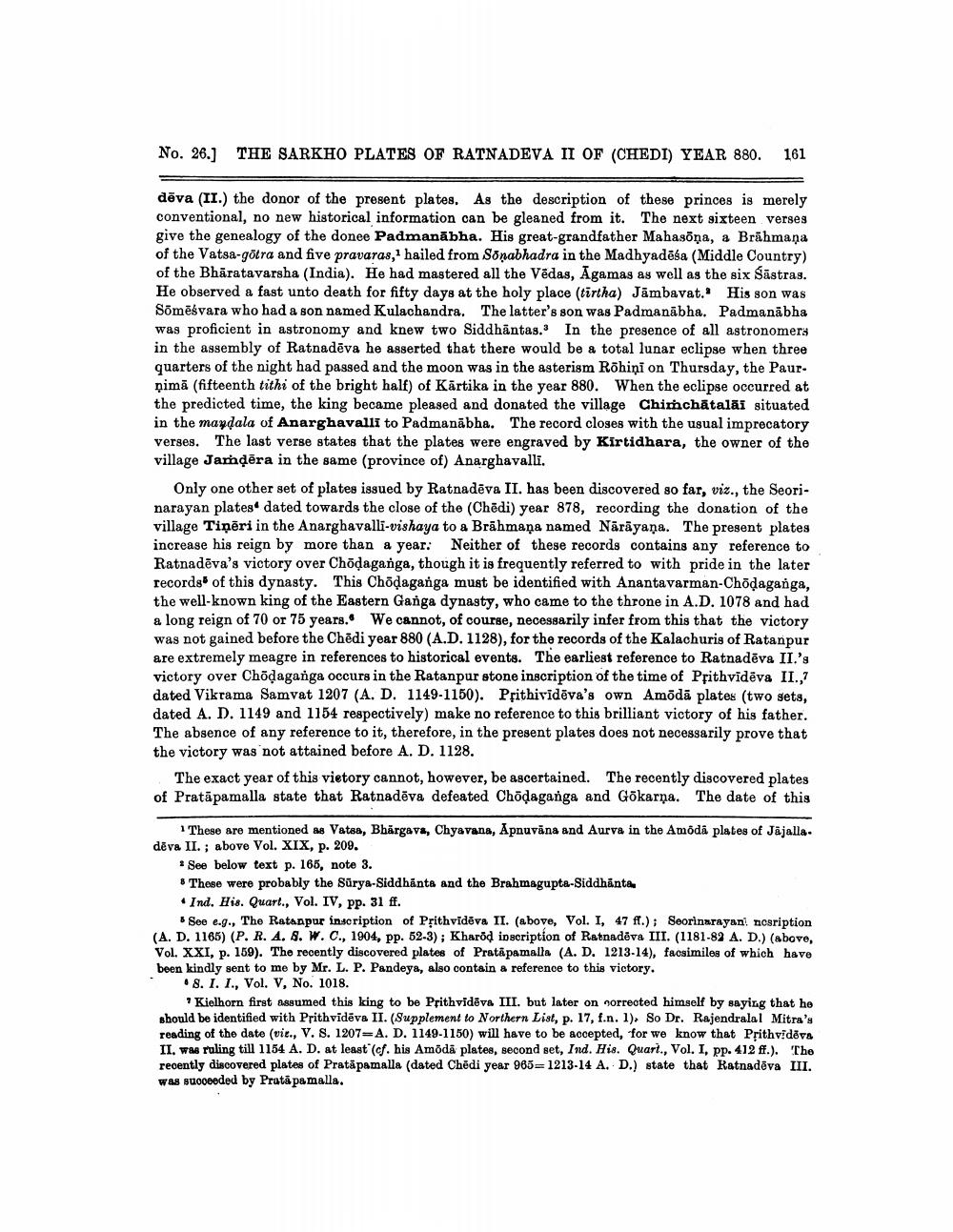________________
No. 26.] THE SARKHO PLATES OF RATNADEVA II OF (CHEDI) YEAR 880. 161
dēva (II.) the donor of the present plates. As the description of these princes is merely conventional, no new historical information can be gleaned from it. The next sixteen verses give the genealogy of the donee Padmanābha. His great-grandfather Mahasõna, a Brāhmaṇa of the Vatsa-götra and five pravaras, hailed from Sonabhadra in the Madhyadēša (Middle Country) of the Bhāratavarsha (India). He had mastered all the Vēdas, Agamas as well as the six Šāstras. He observed a fast unto death for fifty days at the holy place (tirtha) Jämbavat. His son was Sömēsvara who had a son named Kulachandra. The latter's son was Padmanabha. Padmanabha was proficient in astronomy and knew two Siddhāntas. In the presence of all astronomers in the assembly of Ratnadēva he asserted that there would be a total lunar eclipse when three quarters of the night had passed and the moon was in the asterism Röhiņi on Thursday, the Paur. nimā (fifteenth tithi of the bright half) of Kārtika in the year 880. When the eclipse occurred at the predicted time, the king became pleased and donated the village Chimchătalāí situated in the maydala of Anarghavalli to Padmanābha. The record cloges with the usual imprecatory verses. The last verse states that the plates were engraved by Kirtidhara, the owner of the village Jamdēra in the same (province of) Anarghavalli.
Only one other set of plates issued by Ratnadēva II. has been discovered so far, viz., the Seorinarayan plates dated towards the close of the (Chēdi) year 878, recording the donation of the village Tiņēri in the Anarghavalli-vishaya to a Brāhmaṇa named Nārāyana. The present plates increase his reign by more than a year. Neither of these records contains any reference to Ratnadēva's victory over Chōdaganga, though it is frequently referred to with pride in the later records of this dynasty. This Chōdaganga must be identified with Anantavarman-Chödaganga, the well-known king of the Eastern Ganga dynasty, who came to the throne in A.D. 1078 and had a long reign of 70 or 75 years. We cannot, of course, necessarily infer from this that the victory was not gained before the Chēdi year 880 (A.D. 1128), for the records of the Kalachuris of Ratanpur are extremely meagre in references to historical events. The earliest reference to Ratnadēva II.'s victory over Chödaganga occurs in the Ratanpur stone inscription of the time of Prithvidēva II..7 dated Vikrama Samvat 1207 (A. D. 1149-1150). Prithividēva's own Amõdā plates (two sets, dated A. D. 1149 and 1154 respectively) make no reference to this brilliant victory of his father. The absence of any reference to it, therefore, in the present plates does not necessarily prove that the victory was not attained before A. D. 1128.
The exact year of this vietory cannot, however, be ascertained. The recently discovered plates of Pratāpamalla state that Ratnadēva defeated Chōdaganga and Gökarņa. The date of this
These are mentioned as Vatsa, Bhargava, Chyavana, Apnuvāna and Aurva in the Amoda plates of Jājalla. dēva II. ; above Vol. XIX, p. 209.
* See below text p. 165, note 3.
These were probably the Sürya-Siddhanta and the Brahmagupta-Siddhanta • Ind. His. Quart., Vol. IV, pp. 31 ff.
* See e.g., The Ratanpur inscription of Přithvidēva II. (above, Vol. I, 47 ff.); Seorinarayan ncsription (A. D. 1165) (P. R. A. &. W. C., 1904, pp. 52-3); Kharod inscription of Ratnadēva III. (1181-82 A. D.) (above, Vol. XXI, p. 159). The recently discovered plates of Pratapamalla (A. D. 1213-14), facsimiles of which have been kindly sent to me by Mr. L. P. Pandeya, also contain a reference to this victory.
* 8. I. 1., Vol. V, No. 1018.
Kielhorn first assumed this king to be Prithvidēva III. but later on morrected himself by saying that he should be identified with Prithvidēva II. (Supplement to Northern List, p. 17, f.n. 1), So Dr. Rajendralal Mitra's reading of the date (vit., V. S. 1207=A. D. 1149-1150) will have to be accepted, for we know that Prithvidēvs II. was ruling till 1154 A. D. at least (cf. his Amodā plates, second set, Ind. His. Quart., Vol. I, pp. 412 ff.). The recently discovered plates of Pratāpamalla (dated Chedi year 985= 1213-14 A, D.) state that Ratnadēva III. was succeeded by Prutā pamalla.




